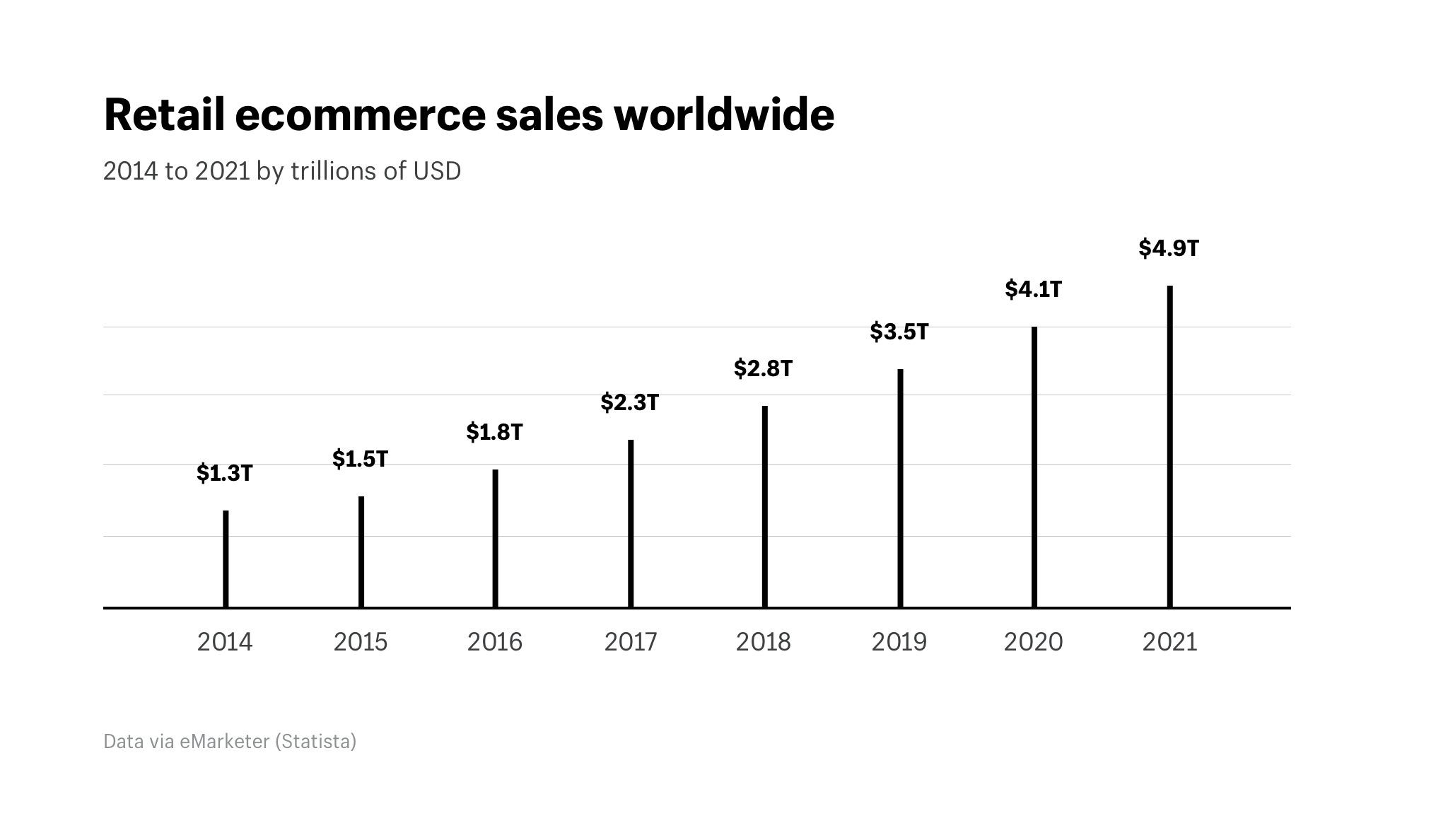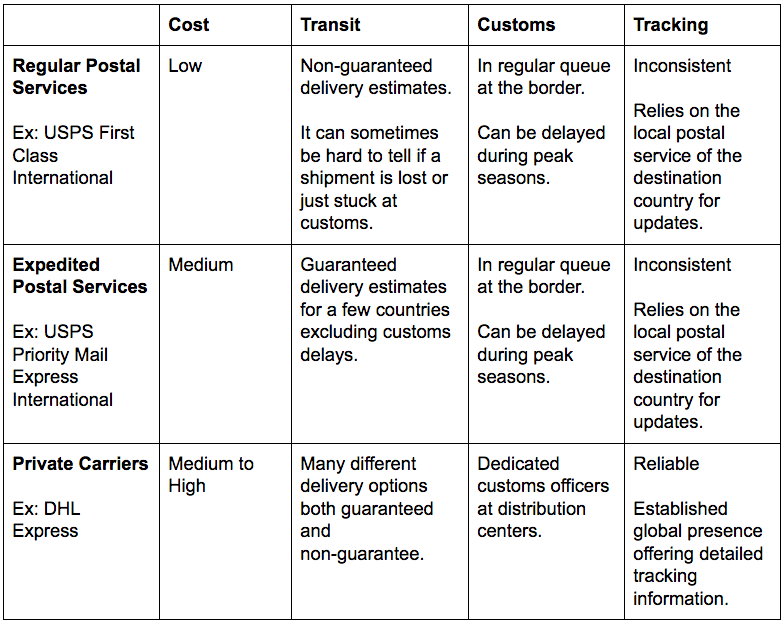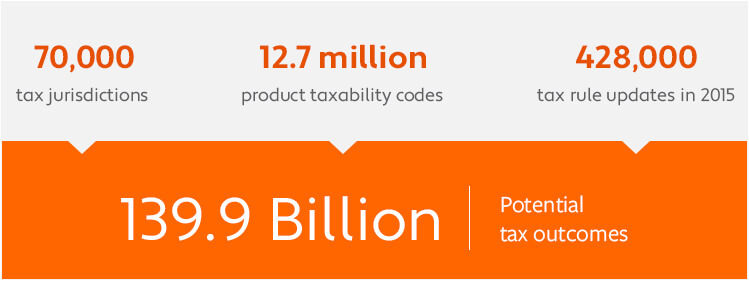“Innovative.” “Brilliant.” “Everything I hoped for.” “Worth every cent.”
Those are just a few of the words customers and investors have used to describe your brand. Better yet, your sales volume and growth rates prove those claims with cold, hard numbers. Kudos!
There’s just one problem: all those kind words — and all those growing sales — are from a single, domestic market.
It’s great you’ve dominated your company’s country of origin. But are your eyes wide open to the soon-to-be $4.9 trillion global ecommerce pie? More to the point: do you have a smart global ecommerce strategy?

What exactly is a “smart global ecommerce”? Simply put: taking a smart approach means you’ve done your research and set up a proactive infrastructure to avoid potential obstacles, integrate into the marketplace, and sail past your competition.
Luckily, a great many entrepreneurs have paved the way for global business. So there’s a wealth of resources, best practices, and advice available to you to help make your transition successful right from the start. Overall, the process of expanding internationally can be a rough one, but if you’re considerate about it, your journey could be smooth. Don’t let it intimidate you. With the right planning and groundwork, you can be successful overseas.
To guide you through the process, we’ve prepared the following checklist that includes everything a business needs.
1. Set Up an International Business License
Whether you’re planning to go multi-channel or sell through a physical storefront, you’ll need an international business license. It indicates that a company has the government’s approval to operate legally. Business licenses allow governments to monitor business activity and impose taxes. Without proper licensing, you risk expensive penalties.
Licensing requirements vary based on the country you plan to sell in. In some nations, business licenses are regulated by all levels of government (federal, state, and local). For instance, if you’re a foreign company planning to sell in the US, you need to have a registered business, an ITIN (Individual Taxpayer Identification Number), and a sales tax permit before you can apply for a business license and other permits.
Once you have these in order, you can visit the US Small Business Administration’s website to know what licenses you need to obtain and how should you register. Expect to undergo a different procedure in other nations …
China
Foreign-owned ecommerce businesses need a commercial ICP (Internet Content Provider) license to sell in China. This license allows a company to engage in payment integration and online sales. Chinese ISPs will block the site if an ICP isn’t obtained within a grace period. Foreign sites first need to have some sort of a Chinese business license before they can apply for an ICP. Those looking to expedite the process can get assistance from companies who understand the Chinese business landscape, such as Twinova.
France
In France and other EU countries, you have to register to VAT and get a VAT number if the distance sales to consumers in EU cross a certain threshold (€35,000 per annum in most instances). If the foreign seller doesn’t have a registered business in the EU, they have to appoint an agent whose company is registered to VAT. The agent will then file the VAT returns for the seller. For instance, Corintax Consulting is a French company with expertise in fiscal representation service for foreign businesses. Appointing them as your VAT agent will lift the burden of managing VAT formalities from your shoulders.
Australia
Foreign entities that wish to sell in Australia through smart global ecommerce have to be licensed with ASIC (The Australian Securities and Investments Commission). The governing body outlines the criteria that define the rights foreign businesses hold in Australia. Merchants who want to obtain business premises in Australia will need additional licenses depending on the jurisdiction they choose.
Companies like LawPath can help expedite the process by analyzing a company’s information and then recommending the next steps to keep its business complaint.
Others
It may be worth checking out LegalZoom if you’re expanding from another country to the US. After you tell the company about your business, it will use proprietary technology to search the national database of governmental license and permit data. Also, LegalZoom presents you with contact information of relevant authorities.
In other countries, you may be able to use the government’s sites for license search. For instance, United Kingdom’s government offers a license finder tool at GOV.UK that shows what type of licenses you might need for lawful business activity.
2. Find Local Suppliers and Manufacturers
You can have the best products in the world, but without local vendors and manufacturers for the items you offer, it can be a struggle to meet consumer demand in a new market (especially if it takes you several weeks to make the product in your home country, then another few weeks to get it delivered to the buyer).
The smart global ecommerce move would be to use local vendors and manufacturers to get your product to market faster. Depending on your target country, you may also be able to benefit from lower manufacturing costs.
A good place to start looking for a local supplier or manufacturer is an online supplier directory.
Alibaba is the largest online business-to-business trading platform in the world, handling sales between importers and exporters in over 190 countries and regions. Their online platform makes it easy to search for suppliers by product, country, and region. Although some businesses have problems with scammers and low-quality products, Alibaba’s free Trade Assurance service helps reduce risk and create trust between buyers and suppliers.
I suggest going through this case study of a Shopify employee named Corey Ferreira. He managed to build a profitable business in a span of 5 months selling gaming glasses from Alibaba. According to Corey, Alibaba made sense as she wanted to find a supplier that could create the exact glasses he wanted, at a good cost. He also states that it would be nice to deal with suppliers who have Trade Assurance.
Most businesses on Alibaba offer this and it ensures that your payment is protected under Alibaba in case anything goes awry.
If you’re interested in using Alibaba, it might be a good idea to start with AliExpress, Alibaba’s retail platform. Although product prices are generally higher, AliExpress’ low minimum order quantity and fast shipping allow you to quickly check manufacturing quality by placing small orders from a variety of suppliers. In addition, see if you can get free shipping, as you’d be selling in the same country where you source products from.
ThomasNet, TradeKey, Kompass and Global Sources are some other popular online supplier directories that list a large number of suppliers in most countries around the world. India Mart has a large network of suppliers based in India and could be a good choice if you’re planning to sell in the South Asia region, and HKTDC is the major directory for suppliers based in Hong Kong.
Trade shows can also be a great place to find suppliers and manufacturers. With hundreds of vendors gathered in one single location, trade shows give you the opportunity to physically inspect and compare sample products from a variety of suppliers. They also give you the chance to meet vendors face-to-face, which is an important step in building a solid business relationship. At a trade show, you’ll be able to shake hands, look the vendor in the eye, and ask any question you might have about production or supply.
Discussing the product with the vendor may even bring up issues you hadn’t previously considered.
If you’re considering attending a trade show, the most important thing you have to do is research the event before attending. Trade shows are usually held in exhibition centers that are the size of multiple sports stadiums (this year’s Canton Trade Fair had over 60,000 booths with an exhibition space of 1,180,000 square meters!), which means you could waste days wandering from booth to booth without ever finding a good supplier.
Most trade shows have a dedicated website, so it’s a good idea to visit the site beforehand to download maps and supplier lists. Research each supplier’s details and production capabilities, make a list of any questions you want to ask them, and come up with a plan for when you want to visit each booth.
There are thousands of trade shows each year in countries all over the world, so you’ll need narrow down your choices by attending shows that are specifically related to your product and market. ExpoDataBase, The Tradeshow Network and TradeFairDates each allow you to search for trade shows by industry and date.
Two often overlooked sources of supplier and manufacturer information are your target market’s local embassy or consulate, and your own country’s embassy in your target market.

Embassies have a focus on promoting trade between countries, and their foreign trade department may keep listings of trusted suppliers and manufacturers with international trade experience. They should also be able to provide you with contact details for the Chamber of Commerce in your target market.
Some companies also prefer working with sourcing agents when it comes to finding local vendors. Though a more expensive route to take, sourcing agents are able to utilize their networks to recommend better suppliers. Also, they might be able to negotiate better contracts with manufacturers.
For overcoming language barriers, consider hiring a translator. If the supplier is fluent in English and understands you well, you might get things done without a translator’s help. Otherwise, you should consider working with a native speaker who is also aware of the business culture in your target market to ensure your suppliers clearly understand your expectations.
It’s important to work with a translator you can trust, so it’s a good idea to check references and qualifications before hiring a translator. See what kind of companies they’ve been working with and in which areas of business translation they are most proficient. Word of mouth can also be helpful for finding a good translator. If you’re a member of a trade organization or have acquaintances that regularly do businesses in your target market, it might be a good idea to let people know that you’re looking for a reliable translator.
3. Investigate Local Warehouses
Once you’ve found suppliers or manufacturers for your product, the next step is deciding where you’re going to store your inventory. Location is important for smart global ecommerce, as keeping your products close to your customers allows you to save on shipping costs and delivery times, and helps improve your customer experience.
There are two main warehousing options for smart global ecommerce – using a 3PL warehousing and fulfillment service or opening your own warehouse in your target market.
Using a 3PL warehousing and fulfillment service can be a good solution for businesses that want to balance the risks of entering a foreign market with the benefits of having a solid global shipping infrastructure and local warehousing. International fulfillment services take care of every step of the delivery process, from storage and packing to shipping and returns.
When choosing a 3PL solution, it’s important to find one that has warehouses located in your target market, as this can help reduce shipping costs and delivery times. Look for a 3PL that has transparent and predictable pricing, as you’ll be responsible for both warehousing fees (e.g. employee salaries, electrical bills, equipment costs) and fulfillment fees (e.g. receiving fees, pick and pack fees, shipping costs). Also, some 3PL partners charge a minimum monthly fee in the event that the client experiences a sluggish month of fulfillment.

A good place to start looking for a 3PL service is a list of top rated companies. Armstrong & Associates, Supply Chain Brain and Inbound Logistics each have a comprehensive list of 3PL companies with information about annual revenue, coverage and services.
Shopify’s integrations with robust inventory management systems make international warehousing easier as well.
For instance, PeopleVox is a company that provides ecommerce specific, cloud-based warehouse management software. It was selected as one of the first members of the Shopify Technology Partner Program. PeopleVox provided British retailer Mothercare with a back-end warehouse solution that could easily integrate with their ecommerce software and be rolled out across their 60+ franchise stores across the globe without the need for any investment or technical infrastructure modifications.

Another option is to open an international warehouse. Though it requires a large initial outlay, it can be a very profitable long term investment for businesses that are planning to ship a lot of orders to a single country and want control over every aspect of the sales process. This approach can be risky - you’ll need to secure a local warehouse, manage local staff, and be fully aware of local business laws.
If you’re considering building your own warehouse, it’s important to note that the time involved in finding a contractor, getting permits, and constructing the warehouse varies from country to country. Data from the World Bank shows that in Singapore, building a warehouse can take as little as seven weeks, while in China it will take around nine months.

Leasing a warehouse could also be a good option. You’ll have to consider things like location, facilities for your staff, health and safety standards, and language difficulties when communicating with site management.
Before making the decision to build or lease a warehouse, it’s a good idea to talk through all the options with an advisor. The International Warehouse Logistics Association can provide information, advice, and contacts that can help you with opening a warehouse in a foreign market.
If you’re unsure whether to start with a 3PL or go straight to opening your own warehouse, I’d suggest beginning with the safer option. Start with a 3PL while you gauge market demand, then consider opening your own warehouse once demand proves sufficient. If the worst happens and your product doesn’t sell, it’s much easier to stop using a 3PL than it is to deal with getting rid of a warehouse, equipment, and foreign staff.
4. Select Local Shipping Providers
The key to success in cross-border shipping is finding the right balance between speed and affordability. You need to keep your customers happy by providing cheap and fast shipping, while also making sure the associated costs don’t cut too far into your profit margins.
For both cross-border shipping and local shipping, you have three main choices: regular postal services, expedited postal services, and private carriers.

Private carriers offer fast shipping times and will take care of required paperwork, but are more expensive than postal services. In developed countries, the national postal service will often provide competitive rates and quick delivery times for domestic shipping. However, in some underdeveloped countries, it is often safer to use a more reliable private shipping company.
It’s important to be fully aware of all the extra fees involved with shipping such as customs duties, taxes, and tariffs. You’ll also need to have a solid plan in place for dealing with product returns. DHL, FedEx, UPS and USPS provide detailed shipping guides that can help you learn more about cross-border shipping.
If you have a good idea of the average size and weight of your shipments, you can use the following calculators to compare costs:
If you’re using a 3PL storage and fulfillment service, it’s a good idea to talk to them about the best shipping options available for your specific target market. They may be able to advise you about local shipping companies, and may also offer discounted shipping with their preferred shipping partners.
Shopify integrates with a variety of trusted 3PL fulfillment services such as Fulfillrite and Shipwire, and these services have helped many merchants take their ecommerce business global. Invention kit maker Joylabz is one of many companies that has found success using Shipwire’s strategically located fulfillment centers for shipping to international customers.
After a successful 2012 Kickstarter launch, interest in Joylabz’ Makey Makey product grew to the point that the company began looking for an international fulfillment provider that could manage both storage and shipping. With Shipwire’s help, Joylabz was able to offer cost-effective shipping to international markets, without needing a centralized warehouse.
Rachel Silver, Joylabz’s Customer Relations Manager, talked about the possibilities that emerged from this partnership:
Now, if a kid halfway around the world watches our (Kickstarter) video and is inspired, he can get a Makey Makey delivered in just a few days without paying exorbitant shipping fees
Joylabz now sells in 130 countries on six continents.
5. Enlist Native Language Writers for Translation
Expanding to a non-English speaking market can be very profitable. According to Capita TI’s research, merchants can reach 90% of the globe’s economic opportunity by targeting the following 13 languages:

However, as 75% of shoppers won’t even consider using a site that isn’t in their language, offering a native language shopping experience is an absolute necessity.
There are two main options for offering a native language shopping experience - localizing your main ecommerce site or offering multiple sites with dedicated language storefronts. For Shopify customers, I’d suggest going with the second option. Shopify allows you to make multiple clones of your store, which means creating a dedicated language storefront for each target market is easy. You can set a domain name, products, currency options, and shipping options that are country specific. You can also tailor the design of your site to appeal to a specific market. For example, if your site has a green theme, you’ll most likely have no trouble appealing to Western customers. However, you might consider changing it when creating a dedicated store for a Latin/South American country where green is the color of death.
Whichever option you choose, localization requires more than just adding a currency converter and word for word translation of product descriptions. You’ll need to translate confirmation emails, packing slips, invoices and marketing materials, all while making sure the language you use is both accurate and culturally appropriate.
Some businesses use Google Translate to save time and money, but it’s important to remember that this service has the potential to make embarrassing mistakes. While machine translation has come on in leaps and bounds in recent times, it still hasn’t reached the level where it can make 100% perfect decisions about regional differences in language.
A better way to ensure your site has accurate localization is to employ the services of a human translator, though this can be both expensive and time-consuming for large-scale ecommerce businesses.

You can find native language writers using online freelance marketplaces such as Upwork, Fiverr and Freelancer. These sites give access to thousands of human translators that can translate almost any language pairs you need. Rates for hiring translators usually vary depending on their experience and location. These sites have a comprehensive review system which can help you choose a trusted and skilled translator. The major downside to these sites is that you are generally limited to working with individuals, so if you have a large translation project, it could take a very long time to complete.
Another option is choosing a translation agency that specializes in ecommerce translations. These agencies can offer fast turnaround times by assigning multiple translators to your job, and will usually offer scalable solutions depending on the size of your business. You should receive faster and higher quality translations by working with an agency instead of a freelancer, though the cost of translations will generally be much higher. Some popular translation agencies are Gengo, Textmaster, GPI and Capita TI.
Businesses engaged in smart global ecommerce often choose a combination of machine translation and human translation. This strategy allows for fast, cost-effective and accurate localization.
Another cost-effective option is Bablic Translation which offers both machine translation and human translation services in one package.
You can start off with machine translation and then manually improve it in order to save or even skip on ordering professional human translation.
6. Determine the Local and International Tax Laws
Benjamin Franklin said: “In this world, nothing can be said to be certain, except death and taxes.” Likewise, you can be certain that determining taxes plays an important part in successful cross-border ecommerce.
When setting the price of your product in an international market, you’ll need to accurately estimate the landed cost to ensure reasonable profit margins. The landed cost includes the cost of your product, door-to-door shipping fees, import and export customs duties, and all tax obligations. These obligations may include tariffs levied by the government, sales taxes and local taxes. Your product may also qualify for duty-free entry into countries with a Free Trade Agreement.
It’s important to accurately determine taxes and tariffs, as inaccurate calculation may result in delays in shipping, fines and penalties from regulatory authorities, and reduced profit margins. You also need to communicate any additional tax-related fees to your customers so there are no surprises during the purchase process.
Determining taxes can be both difficult and time-consuming as they vary depending on a number of factors. For example, determining the tariff for a product shipped from the US to an international customer requires knowing the item’s HS or Schedule B number, its country of origin, its destination, and the value of the shipment and shipping costs. You’ll then need to input the data into an online database, and manually update the results on your ecommerce site. Keep in mind, this is just for a single product being shipped to one country. For each additional product and destination country, you’ll have to make separate calculations.
While it’s possible to calculate these taxes yourself using public resources such as the export.gov Tariffs and Import Fees guide, you’ll need to have one or more staff members who have training and experience dealing with international customs regulations to ensure all the taxes and tariffs are accurately calculated. Another option is to employ the services of a third-party customs regulations specialist, such as International Tariff Management or Focus Business Solutions.
A better option for businesses focused on smart global ecommerce is to use cloud-based tax compliance software. These services easily integrate with most ecommerce platforms, allowing international tax and duty obligations to be determined in real time for any product and any destination.
Shopify users have a distinct advantage over other merchants, as Shopify integrates directly with tax compliance solution called Avalara Avatax. With just a few clicks of your mouse, you can setup Avalara Avatax to manage complex tax calculations for all of your products, both domestic and international.

The software automatically calculates rates and rules for 70,000 tax jurisdictions in more than 200 countries, saving you time and protecting you from penalties due to miscalculation.
Let’s Go Global
Now that you’ve seen what goes into smart global ecommerce, it’s time to take the first step towards international expansion. While challenging, the opportunity to introduce your online store overseas has the potential for exponential growth. With the right expansion strategies and sound advice, you’ll be in a strong position to conquer global markets.
Global ecommerce doesn’t have to be a shot in the dark.
If you consider it and think it through carefully while you execute boldly, you can do it well — just like how you dominated your local market. And remember, the world is a big place. China recently surpassed the US to become the world’s largest retail market, and will only continue to prosper. Now, that idea of exploring China’s retail scene suddenly sounds good, doesn’t it?


